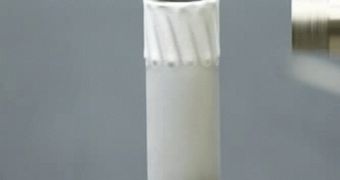Most hobbyists today are happy if they can print some plastic doodad that comes out looking mostly like the model it's based on and even looks presentable from a certain distance.
But the 3D printing industry is forging ahead; professional tools work with all sorts of materials and incredible precision, so much so that fully 3D printed metal guns are now possible.
Still, so far, the focus has been on building new things. However, General Electric is working on changing that with a new technique that could be used to fix broken items rather than just replace them. GE is calling this 3D painting or "cold spray," and it's a fairly interesting development.
"GE researchers announced the use of a process called 'cold spray,' in which metal powders are sprayed at high velocities to build a part or add material to repair an existing part," GE announced.
The process works by building up material in time over the existing part. This has the advantage of making it possible to build or repair huge parts that couldn't be actually 3D printed using current machines.
"Cold spray—also known as 3D painting—demonstrates a unique marriage of materials, process, and product function which can, in the immediate future, transform repair processes for industrial and aircraft components such as rotors, blades, shafts, propellers, and gear boxes," GE explains.
"Since cold spray does not require heat, like common repair processes such as welding, it allows a repaired part to be restored close to its original condition," it adds.
It's called 3D painting because it works in a similar way to spray painting, only instead of paint, it's metal powder that's being sprayed. Using this technique, worn out or broken parts can be restored to their original conditions, greatly increasing the lifespan of a part by years, even decades.

 14 DAY TRIAL //
14 DAY TRIAL // 